Physical, social and cognitive developments are major areas of human development. The term cognition means knowing or understanding [1]. A wide range of human mental abilities are included in it. In the broadest sense, cognitive development refers to mental development, which not only includes intelligence but also perception, recognition, recall and interpretation of information along with all forms of reasoning [2].
Through his observations, Piaget proposed that the development of intellectual abilities occurs in a series of relatively distinct stages and that a child’s way of thinking and viewing the world is different at different stages. Since the thinking of a child is different from that of adults, one cannot expect a child to process and utilize information in the same way that an adult would. Therefore, for efficient communication with a child, it is necessary to understand his/her intellectual level and the ways in which thought processes work at various stages [4].
Piaget categorized cognitive intelligence into various stages, the year’s 4-7 fall in the intuitive stage of the preoperational period of the second period of Piaget’s conceptual intelligence [1].
Seguin form board test is widely used in both research and clinical practice as a performance test of intelligence for young children in our country [5]. It offers various advantages like simplicity, ease of administration, portability, arousal and retention of interest and temporal brevity [5].
This study was undertaken to provide a database and assess Piaget’s principles of the intuitive stage of pre-operational period among 4-7-year-old Northern Indian children relative to their IQ. It was also intended to see whether or not the features of previous stage diminish and successive stage establish with age.
Materials and Methods
This observational study was conducted among 300 children in the age group of 4-7 years of Delhi NCR region of India. Prior to the study, a letter was sent to the principal of the participating schools explaining the nature of the study and seeking permission. Informed consent was duly obtained from the parents of the participants. The children were divided into three groups based on their age. Group I comprised of children who had completed four years of age but not yet completed five years of age. Group II consisted of children who had completed five years of age but not yet completed six years of age. Group III contained children who had completed six years of age but not yet completed seven years of age.
Sample size estimation was done by using G Power software. In G Power, a prior power analysis was performed. Then, a Chi square test was chosen. A minimum total sample size of 298 was found to be sufficient for an error of alpha of 0.05, power of 80% and a moderate effect size of 0.25 (judged from a similar type of study). This sample size was rounded off as 300 (n=100 for each group).
IQ of each child was assessed using Seguin form board test [6]. It comprises of ten geometrical figures, as nearly uniform in size as their variety of form allows, cut through an oak board 18 X 12 X 1.5 inches. The board is finished in its natural color and the blocks are painted black. The board was kept horizontally on a table which was low enough to enable the child to look down upon the center of it and have full view of the board. The blocks were kept on the table within the reach of the child, making sure that no block is kept close to its recess. The child was then asked to place the blocks in their respective recesses as quickly and accurately as possible. Each child was given three trials and the time taken and number of errors made for each trial was recorded.
Four experiments were carried out and all the children were asked two interview questions in person to assess the classical characteristics of Piaget’s theory among these children. They were:
Perceptual egocentrism;
Cognitive egocentrism;
Concept of centration;
Concept of reversibility.
The experiments used in the study were based on Piaget’s cognitive theory. Experiment design for each characteristic was as follows:
I. Perceptual Egocentrism:
The child and the interpreter sat across a table. Toys of two different superheroes were placed on the table in front of the child and he/she was asked if he/she could see them. After the child confirmed that he/she could see both of them, an obstruction was placed in between the two toys such that the child could still see both the toys. Then he/she was asked if he/she could still see the superhero toys. After an affirmative reply, the child was asked if the two superheroes could see each other. A positive reply indicated the presence of perceptual egocentrism in the child.
II. Cognitive Egocentrism:
The child was shown three different stickers and was asked to tell his favourite and least liked sticker amongst them. After obtaining a response from the child, a mean monkey was introduced to the child and he was told that the mean monkey always took away your favourite sticker. It was also explained that the mean monkey doesn’t know which sticker is the child’s favourite and that it would first ask him/her and then take it. The child was asked to save his sticker. The experiment was carried out after explaining the entire procedure. The child was given three chances to save his sticker. If the child pointed to his favourite sticker after being asked by the monkey in all the three trials, he/she was considered to possess the characteristic of cognitive egocentrism. On the contrary, if the child was able to fool the monkey by pointing to a sticker other than his favourite, cognitive egocentrism was considered to be absent in him/her.
III. Concept of Centration:
To assess the concept of centration, the classical beaker experiment was used. The child was presented with two identical beakers having the same amount of liquid. Then the liquid from one beaker was poured into a third taller and thinner beaker in front of the child. The child was asked to identify the beaker that contained more liquid. If the child pointed out the taller beaker as the one containing more liquid, he/she was marked to possess the concept of centration.
IV. Concept of Reversibility
To assess the presence of concept of reversibility, the child was shown two similar linear worms of same length made up of same amount of clay. After the child confirmed that the two worms had an equal amount of clay, one worm was changed to a wiggly worm in front of the child without addition or removal of any clay. The child was then asked if both the worms still had an equal amount of clay. If the child replied with a positive answer, it indicated that the child could reverse the procedure of conversion of straight worm into wiggly worm and could understand that only the shape of the worm was changed without change in amount of clay, thus possessing the concept of reversibility.
Two interview questions were also asked to each child to assess the presence of egocentrism and concept of reversibility in dental settings. They were:
To assess the presence of egocentrism in dental setting, each child was shown four different pictures and was asked what he/she would want to do after his/her dental treatment. The child was asked to choose a picture regarding what his/her best friend should do after their dental treatment. If the child chose the same picture for his/her best friend as he chose for him/herself, the child was considered to be egocentric.
To assess the presence of reversibility in dental setting, each child was shown a series of pictures depicting a sad and dirty tooth, the tooth brushing itself and a happy and clean tooth in the same order. The child was then asked what could he/she do to keep his/her teeth happy. Children who could explain that brushing the teeth and cleaning them was required to keep the teeth happy were marked as ones who had mastered the concept of reversibility.
Statistical Analysis
Data was entered into Microsoft Excel spreadsheet and was analysed using Statistical Package for Social Sciences (SPSS) version 21.0. Categorical variables were summarized as frequencies and continuous variables like IQ score were summarized as mean and standard deviation. Graphs were prepared on Microsoft Excel. Shapiro Wilk test was used to check the normality of the data. Inferential statistics were performed using Chi-square test and Kruskal Wallis test. The level of statistical significance was set at 0.05.
Results
Gender-wise distribution of study population among the three age groups was not significantly different. Males were predominantly more as compared to females in all the groups.
The mean IQ score of group I was significantly higher than that of Group II which was further significantly higher than that of Group III as shown in [Table/Fig-1].
Showing age wise comparison of IQ score. Post hoc pairwise comparison done using Mann Whitney U test reveals that IQ (Group I) > IQ (Group II)>IQ (Gruup III)
pb value<0.001, significant, b Kruskal Wallis test.
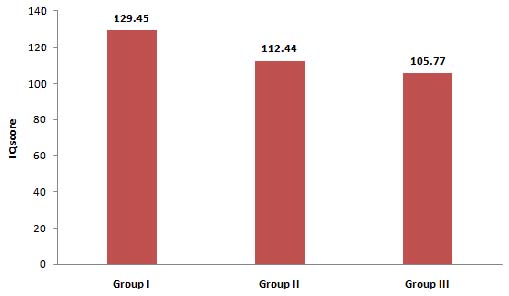
The distribution of children according to their IQ category was significantly different among various age groups. In Group I, significantly higher number of children showed high average and very superior level of IQ as depicted in [Table/Fig-2].
Showing distribution of study population based on their I.Q.
| GROUP | IQ CATEGORY | TOTAL |
|---|
| Extremely lown (%) | Borderlinen (%) | Low averagen (%) | Averagen (%) | High averagen (%) | Superiorn (%) | Very superiorn (%) |
|---|
| I | 2 (2) | 0 (0) | 3 (3) | 11 (11) | 23 (23) | 17 (17) | 44 (44) | 100 |
| II | 2 (2) | 2 (2) | 10 (10) | 29 (29) | 12 (12) | 24 (24) | 21 (21) | 100 |
| III | 4 (4) | 6 (6) | 19 (19) | 24 (24) | 19 (19) | 14 (14) | 14 (14) | 100 |
| Total | 8 (2.7) | 8 (2.7) | 32 (10.7) | 64 (21.3) | 54 (18) | 55 (18.3) | 79 (26.3) | 300 |
p value <0.001, Significant
The prevalence of perceptual egocentrism was found to be significantly higher among Group I (31%) as compared to other two age groups [Table/Fig-3] whereas the prevalence of cognitive egocentrism was not found to be significantly different among all the groups [Table/Fig-4].
Showing intra and inter-group comparison of the prevalence of perceptual egocentrism using Chi square test.
p-value<0.001, significant)
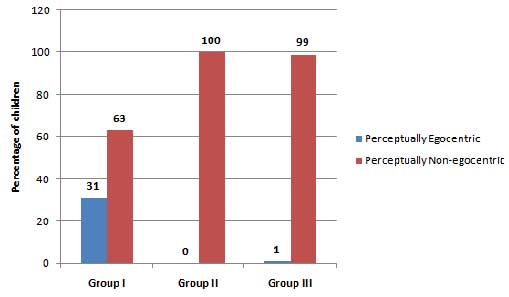
Showing inter-group comparison of the prevalence of congnitive egocenrism using a Chi square test.
(p-value = 0.373, Non-Significant)
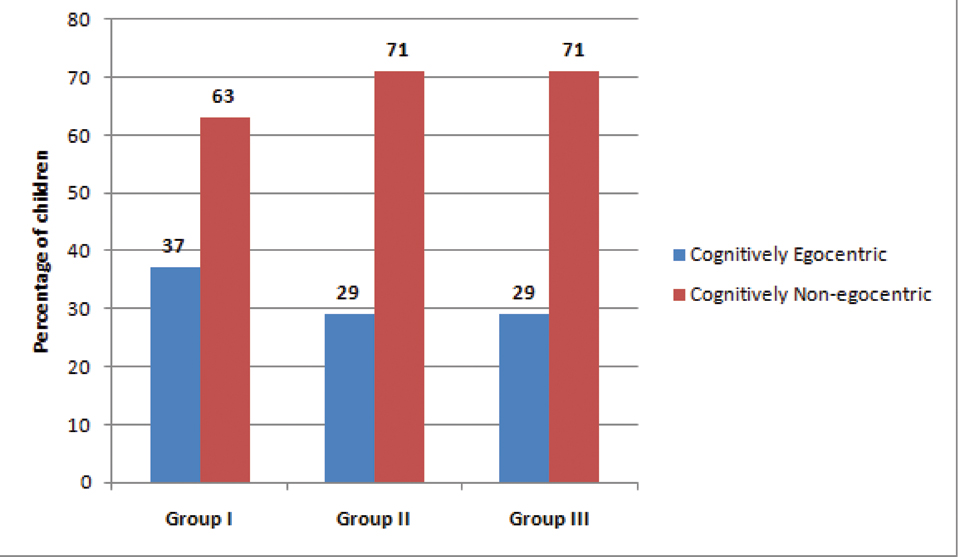
Based on the beaker experiment, a significantly higher number of children showed the presence of centration (p<0.001). On inter-group comparison, lack of centration was found to be significantly higher among Group III as compared to the other groups [Table/Fig-5].
Showing the prevalence of centration. On inter-group comparison using a Chi square test, lack of centration was significantly higher among Group III.
p-value<0.001, significant)
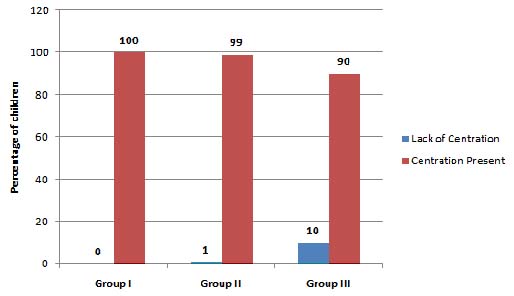
On intragroup comparison, the worm test using clay revealed that significantly higher number of children among all groups lacked the concept of reversibility (p<0.001). Intergroup comparison revealed no statistically significant difference [Table/Fig-6].
Comparing the prevalence of reversibility using a Chi Square test.
p-value = 0.364, Non-Significant
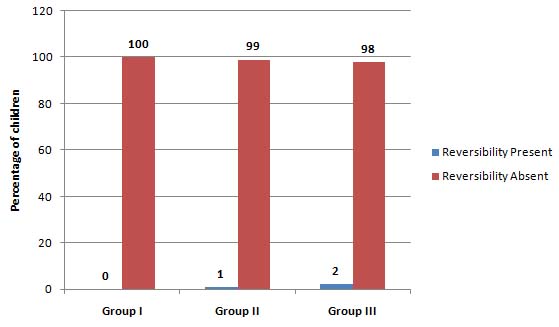
Based on the interview question, the prevalence of egocentrism in dental setting was not found to be significantly different among all groups [Table/Fig-7] whereas as a statistically higher number of children in each group showed the absence of egocentrism in dental setting (p<0.05).
Comparing the prevalence of egocentrism in dental setting. Inter-group comparison using a Chi square test reveals no statistically significant difference in its prevalence.
p-value = 0.282, Non-significant
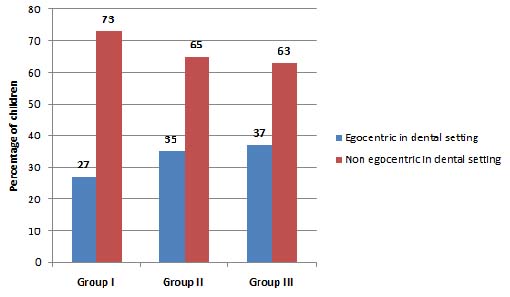
All the children in Group III possessed the concept of reversibility in dental setting based on the interview question, which was significantly higher as compared to 94% among Group I [Table/Fig-8].
Comparing the prevalence of reversibility in dental setting using Chi square test.
p-value = 0.011, Significant
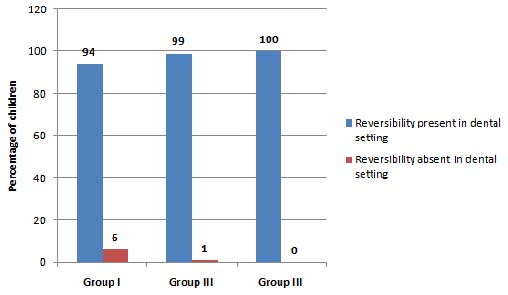
On comparing the mean IQ score of children with characteristics of Piaget, it was observed that there was a statistically significant difference between the mean IQ score of children who possessed or lacked perceptual egocentrism, cognitive egocentrism and egocentrism in dental setting [Table/Fig-9].
Co-relating the mean IQ score of children with Piaget’s characteristics.
bKruskal Wallis test
| Characteristic of Piaget | IQ score | pb-value |
|---|
| Mean | SD |
|---|
| Perceptually egocentric | 125.69 | 28.60 | 0.011, S |
| Perceptually non-egocentric | 114.72 | 25.96 |
| Cognitively egocentric | 119.43 | 23.83 | <0.001, S |
| Cognitively non-egocentric | 108.24 | 30.05 |
| Presence of centration | 119.45 | 17.32 | 0.325, NS |
| Absence of centration | 115.75 | 26.72 |
| Presence of reversibility | 105.33 | 39.26 | 0.936. NS |
| Absence of reversibility | 115.99 | 26.34 |
| Presence of egocentrism in dental setting | 119.12 | 22.48 | 0.02, S |
| Absence of egocentrism in dental setting | 114.29 | 28.08 |
| Presence of reversibility in dental setting | 115.76 | 26.62 | 0.325, NS |
| Absence of reversibility in dental setting | 121.14 | 16.85 |
Discussion
In the preoperational period, the child’s representational abilities become more sophisticated and children learn to use language to communicate ideas to others. The child does not understand the use of symbols and basic operations [2]. The child is preoperational throughout most of the pre-school years, from age 18 or 24 months to 6-7 years of age. Cognitively, these years represent enormous change as the child’s capability of reasoning shows substantial growth [7].
The intuitive stage children between the age of 4-7 years who are usually the most difficult to manage in a dental setting and thus pose a challenge to the dentists were included in the study. (Children under 4 years of age who lacked the cognitive ability to apprehend the study were excluded). The characteristics studied included perceptual egocentrism, cognitive egocentrism, concept of centration and concept of reversibility. This paper has attempted to correlate the prevalence of these features with the age and IQ of a child. It would also help to anticipate and modify a child’s reaction in a dental setting using various behavior management techniques based on his/her level of cognitive development.
In the present study, the mean I.Q score of 4-5 year age group was significantly higher than that of 5-6-year-old which was further significantly higher than that of 6-7-year-old. The distribution of children according to their IQ category was significantly different among various age groups which ranged from extremely low to very superior. In 4-5 year age group, significantly higher number of children showed above and higher level of IQ.
The results of the study showed that prevalence of perceptual egocentrism was found to be significantly higher among 4-5 year age group. This is in accordance with Piaget who believed that by school age or earlier, most children have overcome this characteristic where they do not realize that other people see things from a viewpoint different from theirs. But there is continued cognitive egocentrism, in which children find it difficult to understand that other people do not know their thoughts. In communicating with others, children often forget to put themselves in the role of the listener. In the present study also, prevalence of cognitive egocentrism was not found to be significantly different among all age groups which further supports the principles of Piaget. Based on the interview question, the prevalence of egocentrism in dental setting among all age groups was not significantly different. It also reveals an increase in egocentrism with age. The reason for this increase might be because a child might answer at random. Eg: “If I am going to the playground, then my best friend should also come and play with me.”
Preoperational thought also focuses on a single striking feature of an object or event, a tendency called centration. All the children in the age group of 4-5 years possessed the concept of centration whereas it decreased to 90% in the age group of 6-7 years. Lack of centration was found to be significantly higher among 6-7 year age group as compared to other two age groups. This shows that there is a gradual and significant reduction in the prevalence of centration with increase in age. IQ of the children who responded correctly lied in average (27.3%), high average (9.1%), superior (45.8%) and very superior (18.2%) category. This indicates that elder children and children who had higher IQ showed the presence of decentration.
Another feature of this stage is irreversibility which is the inability to envision reversing an action. According to this study, most of the children among all age groups lacked the concept of reversibility and there was no statistically significant difference with respect to that. Based on the interview question, all the children in 6-7 year age group possessed the concept of reversibility in dental setting which was significantly higher as compared to 94% among 4-5 year age group. This might be because of an increased awareness about the importance of tooth brushing, role of media or a previous exposure to a dentist and dental health education. IQ of the children who possessed reversibility in dental setting lied in average (21.2%), high average (18.4%), superior (18.4%) and very superior (25.6%) category.
The mean IQ score of perceptually and cognitively egocentric children was significantly higher than that of non egocentric children. However, there was no statistically significant difference in the mean IQ score of children who possessed or lacked the concept of centration and concept of reversibility. This could be attributed to a greater number of subjects giving the incorrect response which was expected out of them according to their age.
Clinical application of the study: Knowledge of a child’s thought processes at different ages can be used to improve communication which helps to instill a positive attitude in children and their parents regarding oral health, create an environment to facilitate the child’s ability to ultimately accept care, protect the child’s self-esteem and enhance the work quality and efficiency of the dental personnel [8,9]. For example, it would not be useful to point out to a child how proud his father would be if he stopped sucking his thumb, since the child would think that his father’s attitude is the same as his (egocentrism). Since the child’s view of time is centered around the present, and he is dominated by how things look, feel, taste and sound now, there is also no point in talking to a four-year-old about how much better his teeth will look in the future if he stops sucking his thumb. Telling him that the teeth will feel better now or talking about how bad his thumb tastes, however, may make an impact, since he can relate to that. Taking advantage of egocentrism, the child could be allowed to make believe he/she is in-charge and could be permitted to take some decision about the treatment, e.g., when to temporarily stop using hand signals or allow them to be ‘in-charge’ of the saliva ejector [10]. The dentist should let the child patient know what’s going on and have an active part in treatment [11].
Children between the age of 2-7 years focus at a single compelling feature and thus cannot de-center. The sight of multiple instruments used during dental treatment will tend to terrify such children. Therefore, distracting the child by giving him/her a hand mirror to focus on and watch the procedure might help to ease of his/her anxiety [12-14]. Since a child at this stage of development concentrate on the most striking feature of an object or situation, the dental operatory should provide the child a strikingly colourful and relaxed environment to shift his/her focus away from the “terrifying” instruments.
Limitation
If the study included an older age group of children, where fairly more number of subjects would have given correct responses, a correlation of centration and reversibility with IQ would be more significant.
Conclusion
This observational study provides an insight into the prevalence of Piaget’s characteristics and correlates them with the IQ of 4-7-year-old children. It concludes that perceptual egocentrism disappeared whereas cognitive egocentrism though present, decreased with increase in age. Centration and lack of reversibility were appreciated in most of the children between 4 and 7 years of age. There was a gradual reduction in the prevalence of these characters with increase in age from 4 to 7 years. The mean IQ score of children who possessed perceptual egocentrism, cognitive egocentrism and egocentrism in dental setting was significantly higher than those who lacked these characteristics. Thus, most of Piaget’s principles are still valid today.
p value <0.001, Significant